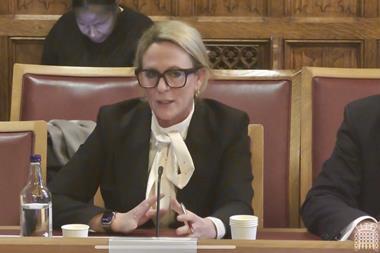As the world's climate takes on a new face, so too must the insurance industry. Sandy Maxwell looks at how things are changing
An increasing number of insurers are turning climate change from a threat into an opportunity, despite the depressing statistics and sense of fatalism surrounding the issue.
The science underpinning climate change is almost beyond question. Only a few rogue scientists are challenging the assertion that the climate is changing rapidly, at least partly as a result of human activity.
Lord Oxburgh, fellow of the Royal Society and former chairman of Shell, said:
"The speed of the temperature rise is unparalleled."
In 2004, the level of carbon dioxide in the atmosphere stood at 379 parts per million (ppm), having risen from 275ppm in the pre-industrial era. At current projections, this could top 550ppm unless radical change is embraced, leading to potentially catastrophic famine and drought affecting millions of people, according to Sir David King, the government's chief scientist.
It's all too easy to despair. Henry Derwent, director of climate change at the Department of Environment, Food and Rural Affairs, knows more than most about the political machinations resulting from the Framework Convention in 1994 and characterises the current global situation as saturated with "innumerable working groups", with the biannual climate change conventions turning into "an extraordinary circus".
Derwent sometimes feels that "the escalator runs down as we run up it" and emissions reduction can be summed up as "a classic game-theory problem without a jurisdiction" as "free riders abound".
But, while governments grapple with the implications of the Kyoto Protocol's emissions targets and Chinese and Indian industrialisation, the insurance industry is all too aware of the risks and exposures associated with climate change.
Natural catastrophes cost the industry a total of $80bn (£44bn) in 2005. Dr Julian Salt, director of the Climate Studies Consultancy, warns that we are at the start of a 10-year active hurricane cycle and up to a billion people are at risk of flooding globally.
Restricting cover
Lloyd's recent paper, Climate Change: Adapt or Bust, addresses these concerns and advises insurers to "regularly review their risk appetite... [and] consider withdrawing or restricting cover in flood-prone hotspots".
ABI director of general insurance, Nick Starling, told our Forces of Nature conference earlier this year that under high-emissions scenarios, by 2080 "average costs would go up by two thirds to three quarters, to $27bn (£14.8bn) a year, and the cost of extreme events would similarly rise very considerably, in the case of the North American hurricanes, by three quarters, to $250bn (£137bn) a year."
But how do you square the apparent circle of reducing emissions and improving the environment on the one hand, and fostering economic growth on the other?
Chris Mottershead, a BP adviser for energy and the environment, argues that it is possible to do both. He says that a realistic assessment of emissions indicates a peak at around 2030.
Mottershead believes governments and regulators have to understand the realities of business: "You cannot change behaviour by talking about constraints." Otherwise you get into "difficult arguments about redistribution of wealth" and unrealistic expectations about the acceptability of economic contraction.
In its recent overview, Climate Change: Business Risk and Solutions, Marsh advised that "There is no current policy that provides explicit coverage for the risk of climate change".
However, Marsh highlights a number of risk-mitigation activities, including "developing new insurance policies that will allow for risk transfer". The broker added: "With insurers becoming increasingly aware of climate risks and opportunities, companies have an opportunity to work with brokers and insurance markets to craft products to address their specific needs and those of their industries."
Tom Delay, chief executive of the CarbonTrust, told the Forces of Nature conference that companies need to realise climate change "is the driver of reputation, cost and profit".
And Marsh's Warren Diogo says that companies are starting to recognise the opportunities out there: "Activity in the market has ramped up in the past few months."
He adds: "There have been some positive steps taken by some of the larger insurers and reinsurers looking at new products for the carbon market."
Diogo says there are a number of different types of risks in relation to the carbon market:
Political risk
The supply of credits to the carbon market is characterised by products located in developing countries. So there are the usual conventional political risks - for example, whether the host government will take action against projects (eg confiscate or expropriate credits).
Credit risk
A number of project counterparties (sellers) involved in the market are new start-ups or less well experienced in terms of project development and technology. They don't all have the strong financials/credit worthiness that European/Western buyers expect or are used to dealing with.
With many projects being established in the developing world (China, India, Brazil etc) there is clearly a question about whether the counterparty will be there to deliver a few years down the line.
Market risks and price risks
The market can be quite volatile. There is certainly an exposure there if you have to go to the market to replace lost credits. AIG and others are developing coverage to protect against price volatility and to provide a cap on the price of credits.
Operational risks
You have to factor in the impact of operational risks and the impact on the delivery of credits. Will the technology perform as expected and will credit be delivered in the volume that was expected?
Traditional natural perils
These risks, along with project delays/interruptions, can also impact on the operation of projects and ultimately on the physical delivery of credits. '
' Diogo would like to see "the packaging of these various products to provide comprehensive coverage for credit delivery failure. If such insurance based solutions can provide delivery certainty this will help to monetise the future value of credits, which will be of real value to the carbon market."
A breath of fresh air
One company to rise to the challenge is Swiss Re. Last month, the reinsurer joined forces with RNK Capita to launch the first insurance product to cover emission-reduction projects under the Kyoto Protocol. Diogo said the new product "focuses on the regulatory risks", initially in relation to the clean development mechanism projects, but with a view to rolling out across joint implementation projects.
And AIG Risk Finance has launched a new bespoke initiative to cover risks associated with carbon trading. Julia Balandina-Jaquier, head of AIG's direct investment in Europe, said the risks associated with climate change are leading to new growth avenues for insurers and reinsurers: "Climate change and sustainability represent a huge business opportunity."
The new product will cover risks in four key areas: operational, credit, political and pricing (for example, if the spot price exceeds the original contract price).
AIG will tailor-make policies for companies involved at all stages of the carbon trading cycle: investors (or lenders), purchasers and sellers.
Ultimately, Philippe Gouraud, senior vice-president at AIG risk finance, wants "insurance protection to become an integral part of the strategy of project owners".
The insurer is already in detailed discussions with a major European chemical manufacturer that has a project in an emerging market.
Contracts will cover a maximum of 80% of the carbon credits to be delivered and will run for up to seven years, to cover the first Kyoto Protocol period.
Other insurers are looking for similar opportunities to encourage sustainability.
In May, Climate Care launched eco-friendly motor and travel insurance policies.
Mark Cliff, of AXA, one of the insurers underwriting the product, said: "It makes sense as an industry that we should be helping to protect the planet and reduce the risk of climate change."
And AXA itself is looking at a pilot scheme to reward corporate policyholders who are environmentally aware.
David Williams, AXA claims director, said: "There is no reason why it should not be possible to offer non-specific discounts on insurance policies for companies focused on contingency planning, general financial risks and have thought about their carbon footprint."
Dedicated cover
New companies have sprung up to cover risks associated with climate change, according to Diogo: "Apart from the traditional larger players, we are also seeing new start-ups emerging looking at providing dedicated products for carbon-specific risks," such as CarbonRe, which has been launched with the sole objective of identifying, assessing and transfering risks in greenhouse gas markets.
So does this mean that insurers have become born-again environmentalists and will refuse to insure projects that increase global warming?
Not quite. According to Alice LeBlanc, head of AIG's new climate change and environment unit: "This is not part of our strategy." It would be commercial suicide for insurers to unilaterally close down revenue streams. In LeBlanc's view, it's up to governments to regulate and create a level playing field rather than the industry to take the first move.
So the major challenge for governments is to create an environment conducive for businesses to create new growth opportunities. After all, multinationals like BP are not going vote for their own demise.
As Mottershead said: "The next conversation is all about the economics." IT
Hosted by comedian and actor Tom Allen, 34 Gold, 23 Silver and 22 Bronze awards were handed out across an amazing 34 categories recognising brilliance and innovation right across the breadth of UK general insurance.













































